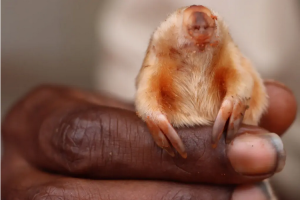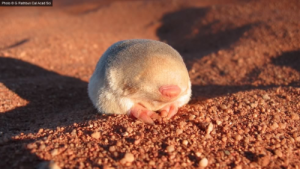Podcast: Play in new window | Download (Duration: 6:33 — 7.3MB)
Thanks to Catherine and arilloyd for suggesting the marsupial mole!
Further reading:
Northern marsupial mole: Rare blind creature photographed in Australian outback
The marsupial mole, adorable little not-mole from Australia [photo from article above]:

Grant’s golden mole, adorable little not-mole from Africa:

Show transcript:
Welcome to Strange Animals Podcast. I’m your host, Kate Shaw.
This week we have a little short episode about a very small Australian animal suggested by two listeners: Catherine, who has the best name ever, and someone called arilloyd who left us a nice review and suggested this animal in the review. I’m not sure I’m pronouncing their name right, so apologies if not. The animal is the unusual but very cute marsupial mole.
There are two closely related species of marsupial mole, one that lives farther north than the other. They look very similar, with silky golden fur, strong, short legs with strong claws for digging, a very short tail, no external ears, and no eyes. The marsupial mole doesn’t have eyes at all. It doesn’t need eyes because it spends almost its entire life underground.
All this sounds similar to other moles, but the marsupial mole isn’t related to other moles. Other moles are placental mammals while the marsupial mole is a (guess, you have to guess), right, it’s a marsupial! That means its babies are born very early and crawl into the mother’s pouch to finish developing. The marsupial mole has two teats, so it can raise two babies at a time.
The marsupial mole grows around 6 inches long, or about 16 cm, and is a little chonky animal with a pouch that faces backwards so sand won’t get in it. It has a leathery nose and small teeth, and its front feet are large with two big claws.
We actually don’t know very much about the marsupial mole because it’s so seldom seen. Not only does it live underground, it lives in the dry interior of Australia, the Great Sandy Desert. It probably also lives in other desert areas of Australia.
Scientists think the marsupial mole originally evolved to dig not in desert sand but in the soft, wet ground in rainforests. Over millions of years Australia became more and more dry, until the rainforests eventually gave way to the current desert conditions. The marsupial mole had time to adapt as its environment changed, and now it’s extremely well adapted to living in sand. It sort of swims through the sand using its big paddle-shaped front feet, kicking the sand behind it with its back legs. Unlike other moles, the marsupial mole doesn’t dig permanent tunnels and the sand just collapses behind it.
While the marsupial mole can’t see, and probably doesn’t have great hearing by our standards, it does have a good sense of smell in order to sniff out insect eggs and larvae, worms, and other small, soft food. It probably searches mainly for insect nests where it can find lots of food at one time, like ant nests. There are also reports of it eating adult insects, seeds, and even small lizards.
The reason the marsupial mole looks and acts so much like placental moles is due to convergent evolution. The mole’s body shape and habits just work really well for an animal that wants to dig around and eat grubs. Like other moles, it has trouble regulating its body temperature since most of the time it doesn’t need to do so. If it gets too hot, it can dig deeper into the sand where it’s cooler.
The marsupial mole is most similar to a completely unrelated placental mammal, Grant’s golden mole, which lives in a few parts of coastal South Africa and Namibia in Africa. Grant’s golden mole lives in sandy areas and swims through the sand like the marsupial mole does. It mainly eats termites and other insects, but it will also eat small reptiles. Its fur is a sandy golden color and it has no external ears, no eyes, and three big claws on its front feet. It only grows about 3 and a half inches long, or 9 cm, which makes it the smallest golden mole. It’s nocturnal and emerges from the sand at night, often hunting aboveground to conserve energy. It mostly hunts by hearing, but since its ears are most effective when it’s underground, it will often stop and stick its head into the sand to listen for potential prey.
Other golden moles are a little bit larger and live in different parts of Africa in different environments, from forests to swamps. But while golden moles are placental mammals, they’re not actually moles despite the name. They look and act like moles, but they’re actually more closely related to the tenrec, which we talked about in episode 324. The golden mole just shares the same traits as true moles due to convergent evolution again.
Just like water animals that all eventually develop a fish-like body shape, it seems that all digging mammals eventually develop a mole-like body shape. That shape also happens to be really cute, which is just a little extra bonus for the animal.
You can find Strange Animals Podcast at strangeanimalspodcast.blubrry.net. That’s blueberry without any E’s. If you have questions, comments, or suggestions for future episodes, email us at strangeanimalspodcast@gmail.com. We also have a Patreon at patreon.com/strangeanimalspodcast if you’d like to support us for as little as one dollar a month and get monthly bonus episodes.
Thanks for listening!